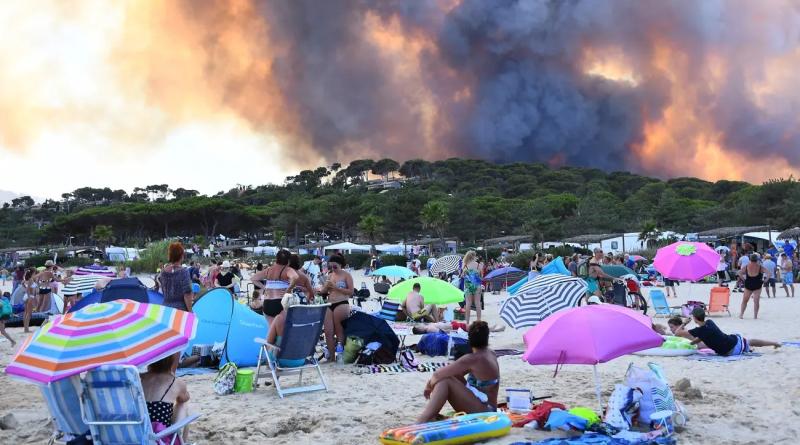Fires, floods and disappearing beaches: can Mediterranean holidays survive?

Shortly after Easter this year, in the midst of a historic, multi-year drought, temperatures in parts of the western Mediterranean climbed a barely believable 20C higher than seasonal norms, hitting a record-shattering 39C in southern Spain.
And that was in April.
As global heating advances, July and August in the world’s most-visited holiday destination – pre-Covid, more than 300 million tourists a year headed to the Med, a figure some predict could rise to 500 million by the end of the decade – risk becoming unbearable.
The Mediterranean basin is a global heating hotspot. While the world is now about 1.1C warmer than it was in the 1970s, the region is already up 1.5C and on course for 3C by the end of the century (or 5C, in a worst-case scenario). Rising temperatures and more frequent heatwaves are not the only challenge. Most climate models agree that in most parts of the world, warmer will also mean wetter – but not in the Med, where rainfall is set to plunge by between 10% and 60%.
When it does fall, experts predict the rain will be more likely to come in the form of violent storms leading to widespread and catastrophic flooding, such as that caused by Storm Alex, which killed 18 people in France’s Alpes-Maritimes in 2020.
Finally, a significantly increased risk of wildfires, and a predicted rise in the Mediterranean’s sea level of between 35cm and – according to some forecasts – more than one metre, could have even more dramatic consequences.
A 2021 report by France’s CNRS national scientific research centre warned that rising sea levels would see miles of beaches vanish, while major population centres, such as Marseille and Nice, would be forced to move inhabitants and rebuild major infrastructure, including airports.
“Even if we completely halted all greenhouse gas emissions today,” said Joël Guiot, a member of the regional climate experts group GREC-Sud, “temperatures would not fall. They’ll stay where they are for decades. We’ve started something we can’t stop.”
It is likely to get hot – sometimes very hot – the group has warned. Picture-postcard Mediterranean scenes will change. Access to areas of natural beauty may be restricted. Beaches could well prove too expensive to maintain.
The Mediterranean holiday began, genteelly, in the Victorian era, grew dramatically after the second world war, really took off when package trips arrived and, since the 1970s, has grown exponentially to now represent 12% of the entire region’s economy (and, in some countries, more than 20%).
So is it irrevocably doomed? Perhaps not. Or at least, not yet.
Experts say that while global heating will inevitably change aspects of the fortnight on the beach in southern France, Spain, Italy or Greece, now so familiar to hundreds of millions of Europeans, the factors that determine tourist flows are altogether too complex to assume it will disappear altogether.
Mediterranean mass tourism, its infrastructures and its popular habits, they note, have been determinedly putting down economic and cultural roots for well over five decades now, catering to a vast, eager and ever-increasing public seeking one thing above all else: guaranteed sunshine.
With sun as the key requirement, they suggest, higher summer temperatures may deter some but certainly not all – and particularly if a holiday destination remains quick, easy and cheap to travel to and stay in. And in that respect, at least, many Mediterranean resorts are, and will probably remain, unbeatable.
So far, French data suggests the recent series of European summer heatwaves has drawn more holidaymakers to more northerly resorts, where sun is far from certain.
The upward curve is not yet sustained, however, and remains relatively marginal: up sometimes 5-10%, but from a relatively low base.
The Med, meanwhile, draws more than twice as many French visitors as Brittany and Normandy combined, and slipped just 0.3% from 2018 to 2019. Evidence so far suggests it is far from losing its pull on the collective imagination of a continent. Last summer, numbers surged to 83% of their pre-Covid level; this summer’s should match 2019’s. There is, certainly, a growing tendency for the season to start earlier and finish later, with more people who are able to choosing to holiday in May, June and September. They are also booking more at the last minute, clearly with an eye on the weather forecast. Peak sunbathing hours are shifting to earlier and later in the day.
Resorts, for their part, are adapting by investing, for example, in more plentiful shade along the coast, planting more trees and promoting “cool spots” – churches, museums, caves – to escape the heat of the day. Regardless of its impact on the planet, air conditioning is now standard in hotels, apartments, restaurants and shops.
“What repels most tourists first and foremost is rain,” insisted Ghislain Dubois, a tourism industry climate change consultant. If what you really want is sunshine, it is still “far easier to put up with high temperatures in the open air, by the sea, with an aperitif, than at home,” he told Le Monde.
On the ground, many remain sanguine. Last year’s record temperatures in Spain, trailing wildfires, deaths, droughts and water restrictions in their wake, undeniably offered a painful glimpse of summers to come. In a country whose sol y playa tourist model has long attracted legions of foreign visitors – and which depends on tourism for more than 12% of its GDP – the effects of the climate emergency are as worrying as they are evident.As in France, a bleak 2016 report by the agriculture, food and environment ministry predicted that a changing climate could erode beaches, flood transport systems, cause water shortages at the height of the season and force ski resorts to close down. The report’s economic forecasts were equally gloomy – especially a prediction that by 2080, tourism from northern Europe could fall by 20% from its 2004 level as rising temperatures there induce people to holiday at home. It foresaw, however, that while some may prefer their own countries – or cooler northern Spain – over its sweltering southern and eastern coasts for their summer breaks, they could well choose to visit the Med in spring or autumn instead.
That’s already happening. “Tourists are coming earlier in the year – the climate emergency is bringing the typical summer months forward,” said Dr Cristina Linares, joint director of the climate change, health and urban environment unit at Madrid’s Carlos III public health research institute. “Although people are still coming to the beaches in the south and east of Spain – and its islands – later on in the summer, tourism is tending to head to the north of Spain, where temperatures are lower during the day but also during the night.”
Linares pointed out that visitors from abroad were often unprepared for the brutal realities of Spain’s ever-fiercer summers. In May 2012, she recalled, a British woman in her 70s died of heatstroke while walking in the Canaries in temperatures of 40.7C. “That was kind of like the first warning of what we could be facing – and of the need to warn tourists about all this, so they know what to do when the temperatures are high,” added Linares.
The health ministry had developed good heatwave emergency plans, she said, but more needed to be done to raise awareness of the dangers for holidaymakers. In the meantime, the focus is on adapting the country to the coming challenges. “We’re working hard on conditioning and remodelling public spaces by installing things like climate refuges, and generally adapting cities in the Mediterranean basin to combat these extreme summer temperatures,” Linares said.
In Athens, continental Europe’s southernmost capital and by far its hottest, preventative measures have included appointing a chief heat officer tasked solely with tackling extreme summer temperatures.
The appointment – the first in Europe – followed a run of record-breaking heatwaves that began in June 2021, fuelled devastating forest fires, and has been seen by meteorologists as a snapshot of what lies ahead. “We know that if we stay inactive we’ll lose the game,” says Elissavet Bargianni, a landscape architect who recently assumed the post. “There has to be more action and more awareness.”
The sense of urgency, evident in the rush of projects to “green and blue” the city, comes as Athens experiences an unprecedented tourist boom. Close to seven million visitors – equivalent to more than half the country’s population – descended on the capital in 2019, with officials expecting more this year.The rebound in a metropolis once viewed as a transit route to the islands has spurred town hall officials to think big. A climate action plan drafted to offset the challenges Athens is likely to face by 2030 foresees green spaces extending across 30% of all urban areas by the end of the decade. Tree planting alone has soared, with 2,122 planted in central Athens last year.
Sustainability is also central to marketing Greece abroad. The country was the third most-visited place in the world last summer, and more than 33 million arrivals are forecast this year. Prolonging the season and promoting offbeat destinations are now key to a sector that accounts for around 25% of GDP and provides one in five jobs.
“The challenges posed by climate change are driving our tourism policies,” says Eleni Skarveli, who heads the Greek National Tourism Organisation in London.
“Extending the season is crucial and, with that in mind, we’ve worked with airlines and tour operators to not only fly into lesser-known destinations but to start in March and end in November. It’s all about sustainability and raising awareness.”
Others have more immediate and practical concerns. In Italy, Simone Battistoni, whose family has run a beach resort on the coast of Emilia Romagna since the 1920s, said his biggest climate battle of the moment – and a major challenge around the Mediterranean – was against coastal erosion. Like many other beach club managers along the coast, which includes the popular Rimini and Riccione, Battistoni had to clear up tonnes of debris washed up along the beach after the northern region was recently engulfed by severe flooding that left 15 people dead and thousands homeless.
But his main challenge will be finding enough space on the beach for his guests after the flooding eroded several metres of sand. “The first three rows of umbrellas and loungers aren’t there any more,” said Battistoni, who is also the president of the union of beach club managers in the Cesenatico area.
“It’s not so much of a problem now, but at the height of the season it could be. We’re working to make enough space, but erosion is an eternal battle between us and the sea. And the sea always wins.”
Last year, the hottest on record, Italy recorded 310 extreme weather events. Twelve people died in flooding in the central Marche region in September, while a further 12 lost their lives in a landslide on the holiday island of Ischia in late November. In the wake of the latest flooding in Emilia Romagna, many foreign tourists backed out. “We had a lot of cancellations for the end of May and early June, mainly from overseas after they saw the images of the floods on TV,” said one hotel owner in Riccione. “This area survives on summer tourism. We’re working hard to recover.”
cover photo:Smoke from a forest fire billowing into the sky in Bormes-les-Mimosas, southeastern France in 2017. Photograph: Anne-Christine Poujoulat/AFP/Getty Images






